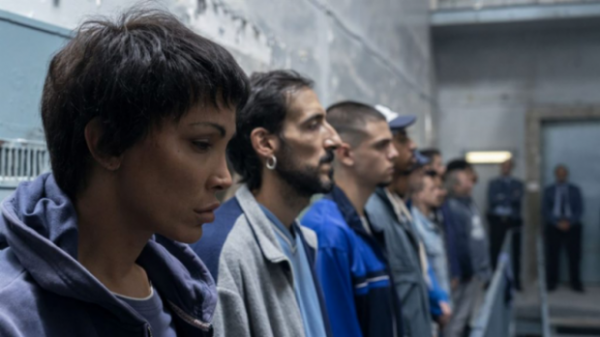by Anamarija Horvat, University of Nottingham
In January 2021, Russel T. Davies’ miniseries It’s a Sin was released on Channel 4. The series tracked a group of queer friends during the AIDS crisis in 1980s London, making it the first example of a UK television series focusing specifically on the British history of AIDS and the devastation it wrought on queer communities. Only a few weeks since its release, the series had been streamed in its entirety more than 6.5 million times, thus positioning it as the most binge-watched show in the history of the All 4 platform. In response to the series, the Terrence Higgins Trust reported both an increase to the number of requested H.I.V. tests, but also a huge boost to donations through its website, which now features It’s a Sin dedicated subsections in which users can take a quiz checking their knowledge of AIDS history and access additional resources on the subject. The connection between the series, its reception and the impetus to learn more about the history of AIDS was further emphasised by the student-aimed newspaper The Tab, which wrote that ‘it has been widely accepted that It’s A Sin has taught us more about HIV and AIDS than any sexual health lesson ever attempted to. Equally, in a mere five hours, the series taught us more about the 1980s AIDS crisis than any of the many history lessons we attended at school.’
As the example of It’s a Sin highlights, media such as film and television can play a complex role in how queer history is remembered, inspiring viewers to both learn about the past and, as The Tab article shows, question the absence of such knowledge in their educational systems. In turn, while Davies’ show is a notably successful example of British AIDS memorial television, it also illustrates a larger trend in contemporary queer cinema and television, with both media looking resolutely backwards, and displaying a notable preoccupation with dramatising and reimagining LGBTQ history. Such works have formed the impetus for my recently-published monograph Screening Queer Memory: LGBTQ Pasts in Contemporary Film and Television, in which I examine how film and television have both commented on, as well as participated in the creation of queer memory. In it, I argue that queer cinema and television play a particularly relevant role with respect to how LGBTQ communities envision their own past, with queer community memories being formed in ways that differ from other minority communities.
The importance of these media works to queer memory stems from the continuous history of erasure and deliberate forgetting to which LGBTQ histories have been consigned within more ‘official’ commemorative methods, be they national commemorative rituals or school history classes. In the UK context, only Scotland mandates that LGBTQ history be taught as part of the curriculum, with this change only taking effect in 2021. In the USA, Nevada has recently become the sixth state to prescribe the teaching of LGBTQ history in the curriculum while, even in states such as California where LGBTQ history has been a mandatory part of the curriculum for the last decade, only 31% of students reported being taught this history as recently as 2019. Such exclusions have had a profound influence on the current state of queer memory or rather, the ways in which LGBTQ histories are habitually forgotten and disregarded from official narratives.
The effects of these omission of queer memory more broadly are compounded by the fact that queer pasts are often also deliberately erased from family histories, with LGBTQ legacies not getting passed on due to discrimination. While many families have queer members, the pervasive presence of homophobia, biphobia and transphobia has frequently meant that mention of their queerness disappears once the family history is being narrated, with heteronormative versions of the past thus overwriting queer histories and experiences. While LGBTQ communities have created numerous community archives, working diligently to preserve the traces of our existence, there are nonetheless countless stories that will forever be lost to us due to the frequent invisibility of queer people to those who were not privy to their identities - an invisibility furthered by the fact that queers have historically been forced to leave little record of their existence in order to survive - as well as the familial and institutional drive to retell and interpret history through the lens of heteronormativity.
Moreover, while LGBTQ archives have worked to counter this invisibility, they are still more likely to be found in large urban centres, with only a small number of these archives currently being digitally accessible to users irrespective of location. In the same vein, many history books about LGBTQ pasts do exist, but need to be actively searched for by the reader, whilst the prevalence of media such as film and television means queer memorial cinema can even be accessed accidentally, as well as being available for streaming transnationally. In the UK context, a particularly relevant example of this took place in 2017, when the fiftieth anniversary of the partial decriminalisation of male homosexuality in England and Wales was commemorated through numerous programmes on both the BBC (through its Gay Britannia season), as well as on Channel 4 (50 Shades of Gay).
In this sense, the passionate reaction which fans have had to It’s a Sin rests in part precisely on the lack of other commemorative cinema and television dealing with the British AIDS crisis, drawing into sharp relief precisely the prevalent lack of education surrounding the history of these events. Echoing the same sentiment, even one of the show’s main actors Callum Scott Howells, who plays Colin, commented that ‘there was nothing [in his own education that taught him about the history of HIV]. Absolutely nothing. Why? How? How can this thing happen, literally kill millions of people, and yet they can't even implement [information about] it in education. They can't even mention it.’ In turn, the intensity with which many fans have responded to the series raises numerous questions about how British AIDS history in general, and particularly the history of AIDS activism is represented. As Kate Manlik’s recent presentation at the Queer Representation: Pasts, Presents, Futures conference has emphasised, the series omits any depictions of the activism of queer women, instead focusing its depiction of activism predominantly on the heterosexual Jill Baxter (Lydia West).
In so doing, the show’s depiction of queer activism follows established trends in queer commemorative cinema and television which I have written about in detail in Screening Queer Memory, relegating the activism of both cis and trans women to the background. Example of such erasure range from the ways in which lesbian separatism is parodied in Matthew Warchus’ otherwise-beloved film Pride, to the particularly notorious erasure of trans and butch women from Roland Emmerich’s Stonewall, the trailer for which inspired an immediate boycott among viewers. As I have written in Screening Queer Memory, through representing ‘queer activist history as a white, male, monosexual and cisgendered endeavour [these narratives] risk obfuscating the ways in which women, transgender men, and people of other races and ethnicities have shaped LGBTQ history, therein relegating them to a secondary role in the movement’s present as well as its past’ (105).

Fig.1.: A scene from a protest depicted in It’s a Sin (2021)
Such media have the potential of shaping not only how we think of the queer past, but also of the present. In Spain, the release of the television series Veneno, created by Javier Ambrossi and Javier Calvo, known locally as ‘los Javis’ (‘the two Javis’) has served as an excellent example of the commemorative role of contemporary queer television, as well as how it can intervene in already-prominent narratives surrounding certain famous figures. The series tracks the life of Cristina ‘La Veneno’ Ortiz Rodríguez, a transgender celebrity whose controversial talk show appearances marked the 1990s, and whose public persona was often presented in an unsympathetic and objectifying light. In tracking Veneno’s life from her childhood and disapproving family, to her days as a sex worker and finally her incarceration in an all-male prison, the series takes a decidedly different approach to her life, instead presenting the transphobic and sexual abuse she suffered with visceral clarity. La Veneno is played within the series by no less than five actors, with the young Guille Márquez and Marcos Sotkovszki embodying her during her childhood days, whilst she is played as an adult by Jedet, Daniela Santiago and Isabel Torres respectively, all of whom are themselves transgender.

Fig.2.: Veneno depicts the incarceration of Cristina Ortiz Rodríguez (Daniela Santiago) in an all-male prison and the rape she suffered there.
Upon its release, the series inspired a powerful reaction from its audience, with subscriptions to the channel ARTESplayer on which the series could be accessed asynchronously rising by 42%. Following its release, Madrid City Council announced a new memorial plaque to the real La Veneno would be placed in the Parque del Oeste, following the first plaque being vandalised and stolen in 2019 within a week of being installed. On Twitter, Spain’s then-vice president Pablo Iglesias also commented on the series, writing that ‘it makes you cry, laugh, remember, empathise but, above all, it makes you comprehend the savage pain which has been and continues to be inflicted on trans people simply for being themselves. I hope many young people see the series’, adding the hashtag #depathologisetransness.
While it is impossible to argue a causal link between the reception of the series and recent changes to Spanish law, it is relevant to note the prominence of the series within a context where legal changes to transgender self-identification were already being proposed. After a considerable amount of controversy due to the vocal opposition of both the far-right and trans-exclusionary feminists, the recent passing of the LGBTI Equality Law in the Spanish Parliament has enshrined in law the right of transgender people to self-identify, as well as other changes such as the introduction of full reproductive rights for cisgender lesbians via access to state-subsidised IVF. While the series was certainly only a part of this political context, the potential power of a work which focuses precisely on the ways in which transphobia and a transphobic legal context have disenfranchised transgender people cannot be overlooked.
Taken together, the influence of series like Veneno and It’s a Sin demonstrates the ways in which contemporary television and cinema participate in the creation of queer memory. These series are anything but outliers, with shows such as Pose, When We Rise, The Assassination of Gianni Versace and Maricon Perdido (The Lost Queer) and films like Carol, Call Me by Your Name, 120 BPM, Rocketman, Tom of Finland and Tell It to the Bees all looking back and reimagining the histories that might have been inhabited by queer people in the past. As Screening Queer Memory argues, ‘far from being over, the tendency towards queer cinematic and televisual engagements with the past seems only to have begun, with LGBTQ representation looking resolutely backwards. The creation of queer memory is thus itself a continuing process, and it is up to us to see how it is being shaped, by whom and, crucially, which political goals for the future it promotes’ (139).